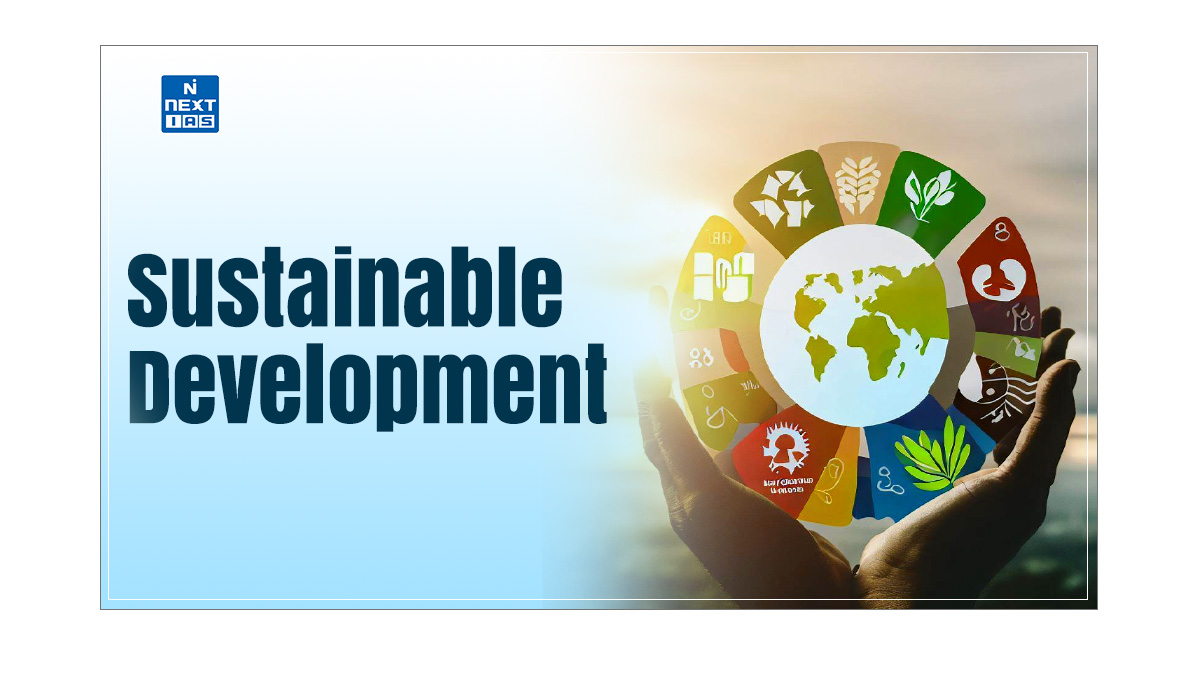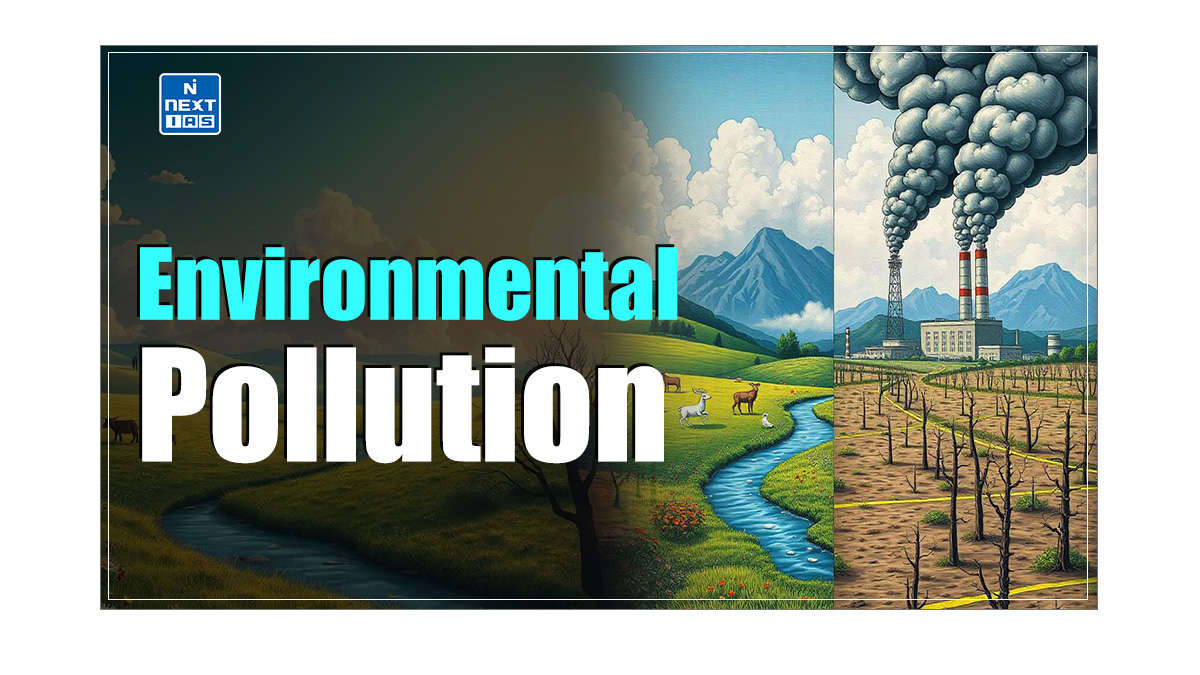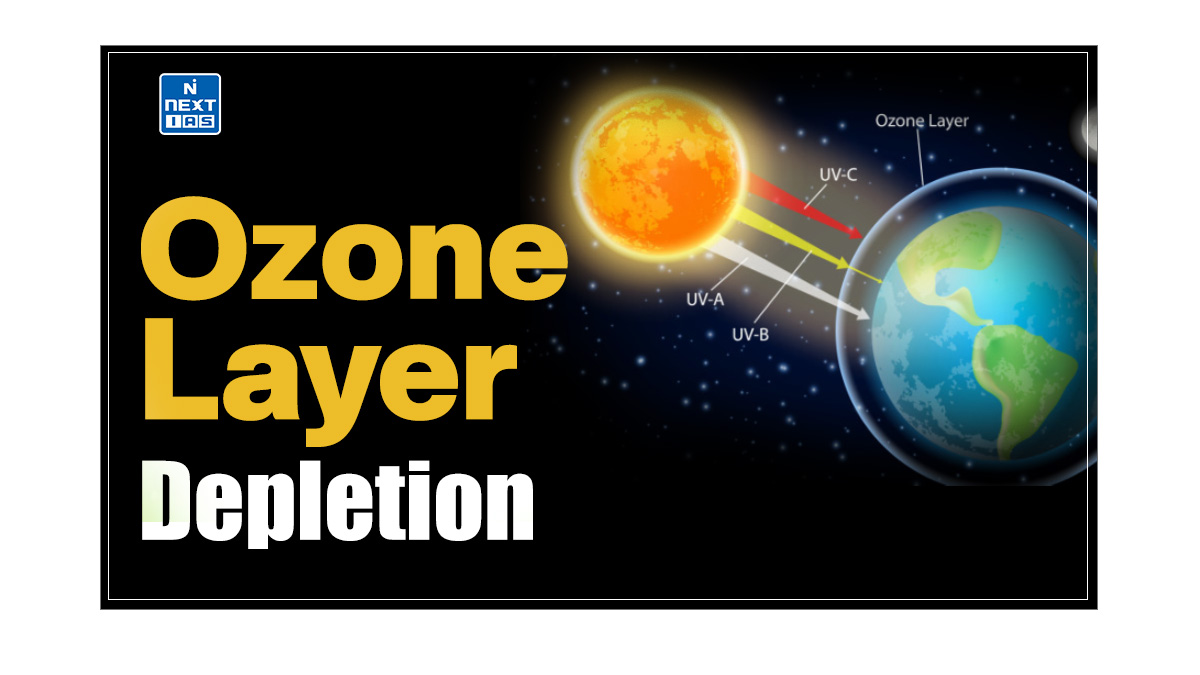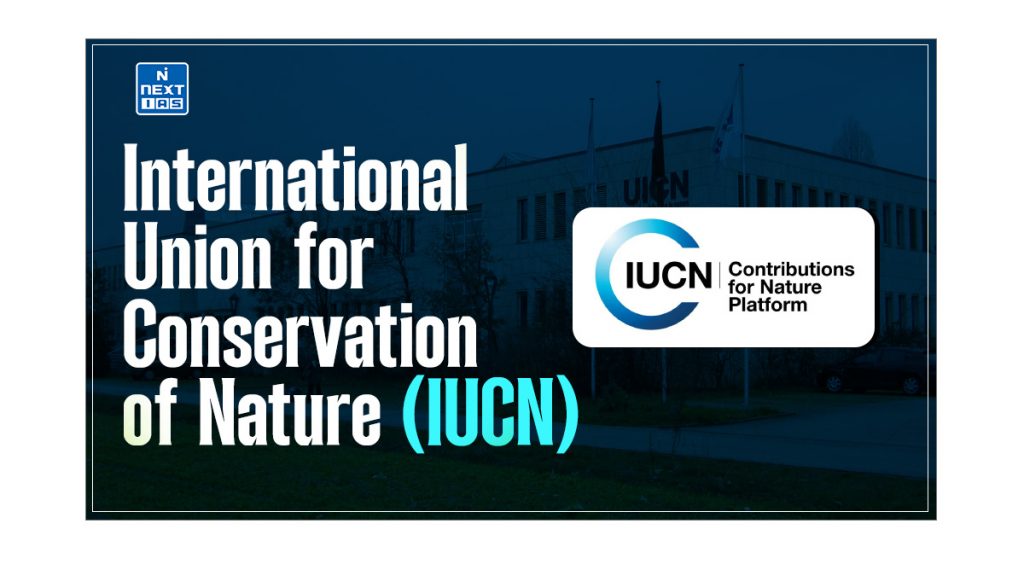
The International Union for Conservation of Nature (IUCN) is a vital global organisation that plays a crucial role in safeguarding the natural world. Its work on biodiversity conservation, protected areas, and sustainable development has had a significant impact on global efforts to protect our planet. This article aims to provide a comprehensive overview of the International Union for Conservation of Nature (IUCN), its objectives, functions, key initiatives and other related aspects.
About International Union for Conservation of Nature
- The International Union for Conservation of Nature is a global organisation that works for the conservation of nature and the sustainable use of natural resources.
- It is a membership Union and is uniquely composed of both Government and Civil Society Organisations (CSOs).
- It provides public, private and non-governmental organisations with the tools and knowledge that enable nature conservation, economic development and human progress to take place together.
- Established in 1948, it has evolved into the world’s largest and most diverse environmental network by harnessing the experience, resources and reach of its 1,300 Member organisations.
- It is the global authority on the status of nature and the measures needed to safeguard it.
| IUCN was founded as the International Union for the Protection of Nature (or IUPN) in October 1948, following an international conference in Fontainebleau, France. Later, it changed its name to the International Union for Conservation of Nature and Natural Resources in 1956 with the acronym IUCN (or UICN in French and Spanish). |
Objectives & Functions of International Union for Conservation of Nature
- The expertise and vast network of the International Union for Conservation of Nature provide a solid foundation for large and diverse conservation projects around the world.
- Combining the latest science with the traditional knowledge of local communities, these projects work to restore ecosystems, reverse habitat loss, and improve people’s well-being.
- It has divided its experts into six commissions dedicated to species survival, protected areas, environmental law, social and economic policy, ecosystem management, and education and communication.
Key Programs of IUCN
- Under its broader objectives, as described above, it has started a number of programs and initiatives across the world, such as IUCN Red List of Threatened Species, IUCN: Nature 2030, etc.
- Some of the key programs of the International Union for Conservation of Nature have been discussed in detail in the sections that follow.
IUCN Red List of Threatened Species
- The IUCN Red List of Threatened Species is the most comprehensive inventory of the global conservation status of plants, animals and other organisms threatened with extension.
- It uses a set of criteria to evaluate and assess the extinction risk of thousands of species and subspecies.
- These criteria are applicable to all species and all regions across the world.
- Backed by a robust scientific basis, the IUCN Red List is acknowledged as the most authoritative guide on the status of global biodiversity.
- Unveiled in 1994, the IUCN Red List is used by Government agencies, wildlife departments, natural resource planners, conservation-related non-governmental organisations (NGOs), educational organisations, students, and the business community.
Objectives of IUCN Red List
The major objectives of IUCN Red List are as follows:
- To provide a system that can be applied consistently by different people;
- To improve objectivity by providing users with clear guidance on how to evaluate different factors that affect the risk of extinction;
- To provide a system which will facilitate comparisons across widely different taxa;
- To give people using threatened species lists a better understanding of how individual species were classified.
IUCN Red List Criteria for Classification
- It uses a set of five quantitative criteria to assess the extinction risk of a given species.
- In general, these criteria consider:
- The rate of population decline
- The geographic range
- Whether the species already possesses a small population size
- Whether the species is very small or lives in a restricted area
- Whether the results of a quantitative analysis indicate a high probability of extinction in the wild
Classification of Threatened Species under IUCN Red List
The IUCN Red List categorises species into the following nine categories:
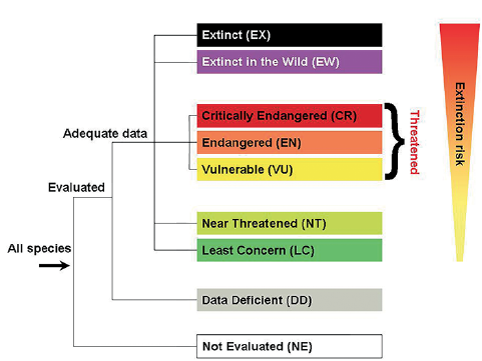
Extinct (EX)
A designation applied to species in which the last individual has died or where systematic and time-appropriate surveys have been unable to log even a single individual.
Extinct in the Wild (EW)
A category containing those species whose members survive only in cultivation, in captivity or as a naturalised population (or populations) well outside the past range or far outside their historical habitats.
Critically Endangered (CR)
A category containing those species that possess an extremely high risk of extinction as a result of a rapid population decline of more than 90% over the previous ten years (or three generations), a current population of fewer than 50 individuals, or other factors.
Endangered (EN)
A designation applied to Species that possess a very high risk of extinction as a result of rapid population declines of 50 to more than 70 % over the previous ten years (or three generations), or individual population numbers fewer than 250 individuals, or other factors.
Vulnerable (VU)
A category containing those species that possess a very high risk of extinction as a result of rapid population declines of 30 to more than 50% over the previous ten years (or three generations), or individual population numbers fewer than 1,000 individuals, or other factors.
Near Threatened (NT)
A designation applied to species that have been evaluated against the criteria but do not qualify for Critically Endangered, Endangered or Vulnerable now but are close to qualifying for or are likely to qualify for a threatened category in the near future.
Least Concern (LC)
- A category containing species that has been evaluated against the criteria and does not qualify for Critically Endangered, Endangered, Vulnerable or Near Threatened.
- These species are pervasive and abundant after careful assessment.
Data Deficient (DD)
- A condition applied to species in which the amount of available data related to its risk of extinction is lacking in some way.
- This happens when there is inadequate information to make a direct or indirect assessment of its risk of extinction based on its distribution and/or population status.
Not Evaluated (NE)
This category is used to include any of the nearly 1.6 million species described by science but not assessed by the International Union for Conservation of Nature.
IUCN: Nature 2030
- IUCN Nature 2030 is a programme marking the culmination of many years of deliberation across the Union and was adopted by democratic vote at the IUCN World Conservation Congress in Marseille.
- The Nature 2030 IUCN Programme, for the first time, sets its goals and targets over ten years.
- This programme of the International Union for Conservation of Nature outlines broad areas of work and sets targets as well as indicators to measure progress.
- It will help the Union deliver for people, land, water, oceans and climate through five pathways for a transformative change: recognise, retain, restore, resource and reconnect.
- Through this worldwide project, the International Union for Conservation of Nature pledges to provide contributions that are both obvious and measurable to the COVID-19 pandemic recovery effort, the post-2020 global biodiversity framework, the Sustainable Development Goals, and the Paris Agreement on Climate Change.
- The programme will focus on five components – People, Land, Water, Oceans, and Climate.
- The International Union for Conservation of Nature has defined the actions under the programme that enable the delivery of the five programme areas. These calls to action are embedded in the following 5Rs:
- Recognise: Recognise the unprecedented challenges faced by the people and the planet, the urgency with which we must act, the necessary steps we must take, and the role everyone can play.
- We also recognise that conservation works, that nature is wonderous, and that many are already working to protect and restore it.
- Retain: Retain the world’s biodiversity and natural and cultural heritage in key biodiversity areas and other places where diversity and traditional knowledge flourish.
- Restore: Restore species populations, ecosystems and the benefits that nature provides to people, capitalising on the UN Decade of Ecosystem Restoration.
- Resource: Resource the movement by mobilising investment in nature and the people working to conserve it through finance, capacity development and generating knowledge.
- Reconnect: Reconnect people, societies and economies to nature and rebuild connections between fragmented habitats.
- Recognise: Recognise the unprecedented challenges faced by the people and the planet, the urgency with which we must act, the necessary steps we must take, and the role everyone can play.
India and International Union for Conservation of Nature
- India became a member of the International Union for Conservation of Nature in 1969 through the Ministry of Environment & Forests.
- IUCN India works with Members and Commissions to:
- Reduce ecosystem and species loss by providing the necessary knowledge and tools to conserve, value, and use biodiversity sustainability;
- Enhance governance and policy to achieve better management of ecosystems and habitats, including protected areas; and
- Address challenges related to climate change, food security and poverty alleviation.
IUCN Programmes in India
Building Community Resilience and Ecosystem-Based Adaptation to Climate Change in the Indian Himalayan Region (CwU)
- The International Union for Conservation of Nature is implementing the CwU project to address critical impacts of climate change on biodiversity, livelihoods, water, and energy, as well as to build climate resilient strategies for reducing ecosystem and community vulnerabilities in the Indian Himalayan region (IHR) through the landscape approach.
- The project aims to improve the adaptive capacity of community and local governance by enhancing the resilience of ecosystem and communities through biodiversity conservation, watershed restoration, livelihood improvements and energy security in the Indian Himalayas.
- Other sub-objectives include the following:
- Documentation of nature-based solutions for climate change adaptation and planning
- Enhancement of community-based adaptation
- Mainstreaming of community-based adaptation strategies in the policy framework
Forest Ecosystem Rehabilitation for Integrated Mitigation and Adaptation Strategies
The project will focus on two strategies:
- Learn and Empower: Identifying national or sub-national “best bets” for optimising coherent implementation of land-based mitigation and adaptation strategies.
- Influence and Optimize: Supporting national or sub-national policy and programme development that integrates the “best bets” and optimises opportunities to bring together existing policies, programmes and processes.
IUCN and TATA Power Partnership
- The International Union for Conservation of Nature and Tata Power are working together to enhance Tata Power’s efforts in biodiversity conservation and management.
- The partnership aims to integrate the conservation of biodiversity and ecosystem services into Tata Power’s corporate policies and align them with global standards.
- The project will review existing approaches adopted by Tata Power and CGPL towards biodiversity management, develop site-specific biodiversity and ecosystem services protocols, and build the capacity of company staff to implement the protocols.
- The final component of the project is to promote best practices amongst the industries in the energy/power sector and conservation communities to influence related policies and laws in India.
Leaders for Nature India (LfN)
- Leaders for Nature (LfN) is a business biodiversity network initiated in the Netherlands by the International Union for Conservation of Nature in 2005.
- LfN engages multinationals to work towards greening the economy.
- In 2012, LfN launched its second network in India.
- Since 2014, IUCN India and IUCN National Committee of the Netherlands, together with their partners CII – ITC Centre of Excellence for Sustainable Development, Hivos, and the Wildlife Trust of India, have been actively running the LfN network in the country.
- LfN’s vision is that by 2050, businesses in India will have implemented solutions to reduce their ecological impacts, resulting in a net positive impact on natural capital; collectively creating an Indian economy that values, conserves and restores nature.
IUCN Himalayan Adaptation Network
- In February 2020, in Sikkim, the International Union for Conservation of Nature launched its web-based network effort known as the “Himalayan Adaptation Network” in recognition of the diverse environmental and climate change challenges and existing initiatives in the Indian Himalayan Region.
- This platform was created as part of the “Coping with Uncertainty: Building Community Resilience and Ecosystem-Based Adaptation to Climate Change in the Indian Himalayan Region (IHR)” project, which is funded by the National Mission on Himalayan Studies (NHMS).
- The project aims to develop climate-resilient strategies for lowering community and ecosystem vulnerability in the Indian Himalayan region (IHR) by using a landscape approach.
- It also addressed the significant impact of climate change on water, energy, livelihoods, and biodiversity.
Conclusion
The International Union for Conservation of Nature remains a cornerstone in global conservation efforts, driving progress towards the protection of biodiversity and the sustainable use of natural resources. Through its comprehensive initiatives, scientific expertise, and influential role in international policy, the International Union for Conservation of Nature continues to play a crucial role in addressing the environmental challenges of the 21st century.
Frequently Asked Questions (FAQs)
What is the full form of IUCN?
It stands for the International Union for Conservation of Nature.
What is the new name of IUCN?
It was previously known as the International Union for the Protection of Nature (IUPN). Later, its name was changed to the International Union for Conservation of Nature.
What is the aim of International Union for Conservation of Nature?
Its main aim is to provide scientific knowledge and tools to aid conservation action and promote international cooperation.
Where is International Union for Conservation of Nature located?
Its headquarters is located in Gland, near Geneva, Switzerland.
Where is the headquarter of IUCN in India?
The headquarters of the International Union for Conservation of Nature India is located in New Delhi.
